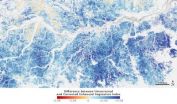(Press-News.org) An international team of researchers, led by scientists from the University of California, San Diego School of Medicine and Indiana University, have identified a protein that broadly regulates how genetic information transcribed from DNA to messenger RNA (mRNA) is processed and ultimately translated into the myriad of proteins necessary for life.
The findings, published today in the journal Cell Reports, help explain how a relatively limited number of genes can provide versatile instructions for making thousands of different messenger RNAs and proteins used by cells in species ranging from sea anemones to humans. In clinical terms, the research might also help researchers parse the underlying genetic mechanisms of diverse diseases, perhaps revealing new therapeutic targets.
"Problems with RNA editing show up in many human diseases, including those of neurodegeneration, cancer and blood disorders," said Gene Yeo, PhD, assistant professor in the Department of Cellular and Molecular Medicine at UC San Diego. "This is the first time that a single protein has been identified that broadly regulates RNA editing. There are probably hundreds more. Our approach provides a method to screen for them and opens up new ways to study human biology and disease."
"To be properly expressed, all genes must be carefully converted from DNA to messenger RNA, which can then be translated into working proteins," said Heather Hundley, PhD, assistant professor of biochemistry and molecular biology at Indiana University and co-senior author of the study. RNA editing alters nucleotides (the building blocks of DNA and RNA) within the mRNA to allow a single gene to create multiple mRNAs that are subject to different modes of regulation. How exactly this process can be modulated, however, has never been clear.
Using the nematode Caenorhabditis elegans as their model organism and a novel computational framework, Hundley, Yeo and colleagues identified more than 400 new mRNA editing sites – the majority regulated by a single protein called ADR-1, which does not directly edit mRNA but rather regulated how editing occurred by binding to the messenger RNAs subject to editing.
"Cells process their genetic code in a way analogous to how the programming language Java compiles modern software. Both systems use an intermediate representation that is modified depending on its environment" said co-first author Boyko Kakaradov, a bioinformatics PhD student in the Yeo lab. "We're now finding how and why the mRNA code is being changed en route to the place of execution."
The scientists noted that a protein similar to ADR-1 is expressed by humans, and that many of the same mRNA targets exist in people too. "So it is likely that a similar mechanism exists to regulate editing in humans," said Hundley, adding that she and colleagues will now turn to teasing out the specifics of how proteins like ADR-1 regulate editing and how they might be exploited "to modulate editing for the treatment of human diseases."
INFORMATION:
Co-authors include Michael C. Washburn and Emily Wheeler, Indiana University; Balaji Sundararaman, UCSD; and Shawn Hoon, A*STAR and Nanyang Technological University, Singapore.
Funding for this research came, in part, from the Ralph W. and Grace M. Showalter Foundation, the National Science Foundation, the Indiana University School of Medicine and National Institutes of Health grants T32 GM007757, R01 HG004659 and R01 NS075449.
Global regulator of mRNA editing found
Protein controls editing, expanding the information content of DNA
2014-02-06
ELSE PRESS RELEASES FROM THIS DATE:
Toxin from brain cells triggers neuron loss in human ALS model
2014-02-06
NEW YORK, NY (February 6, 2014) — In most cases of amyotrophic lateral sclerosis (ALS), or Lou Gehrig's disease, a toxin released by cells that normally nurture neurons in the brain and spinal cord can trigger loss of the nerve cells affected in the disease, Columbia researchers reported today in the online edition of the journal Neuron.
The toxin is produced by star-shaped cells called astrocytes and kills nearby motor neurons. In ALS, the death of motor neurons causes a loss of control over muscles required for movement, breathing, and swallowing. Paralysis and death ...
New insight into an emerging genome-editing tool
2014-02-06
The potential is there for bacteria and other microbes to be genetically engineered to perform a cornucopia of valuable goods and services, from the production of safer, more effective medicines and clean, green, sustainable fuels, to the clean-up and restoration of our air, water and land. Cells from eukaryotic organisms can also be modified for research or to fight disease. To achieve these and other worthy goals, the ability to precisely edit the instructions contained within a target's genome is a must. A powerful new tool for genome editing and gene regulation has ...
Credit card-sized device could analyze biopsy, help diagnose pancreatic cancer in minutes
2014-02-06
Pancreatic cancer is a particularly devastating disease. At least 94 percent of patients will die within five years, and in 2013 it was ranked as one of the top 10 deadliest cancers.
Routine screenings for breast, colon and lung cancers have improved treatment and outcomes for patients with these diseases, largely because the cancer can be detected early. But because little is known about how pancreatic cancer behaves, patients often receive a diagnosis when it's already too late.
University of Washington scientists and engineers are developing a low-cost device that ...
UI researchers evaluate best weather forecasting models
2014-02-06
Two University of Iowa researchers recently tested the ability of the world's most advanced weather forecasting models to predict the Sept. 9-16, 2013 extreme rainfall that caused severe flooding in Boulder, Colo.
The results, published in the December 2013 issue of the journal Geophysical Research Letters, indicated the forecasting models generally performed well, but also left room for improvement.
David Lavers and Gabriele Villarini, researchers at IIHR—Hydroscience and Engineering, a world-renowned UI research facility, evaluated rainfall forecasts from eight different ...
Nanoparticle pinpoints blood vessel plaques
2014-02-06
A team of researchers, led by scientists at Case Western Reserve University, has developed a multifunctional nanoparticle that enables magnetic resonance imaging (MRI) to pinpoint blood vessel plaques caused by atherosclerosis. The technology is a step toward creating a non-invasive method of identifying plaques vulnerable to rupture–the cause of heart attack and stroke—in time for treatment.
Currently, doctors can identify only blood vessels that are narrowing due to plaque accumulation. A doctor makes an incision and slips a catheter inside a blood vessel in the arm, ...
Loose coupling between calcium channels and sensors
2014-02-06
This news release is available in German. Information transmission at the synapse between neurons is a highly complex, but at the same time very fast, series of events. When a voltage change, the so-called action potential, reaches the synaptic terminal in the presynaptic neuron, calcium flows through voltage-gated calcium channels into the presynaptic neuron. This influx leads to a rise in the intracellular calcium concentration. Calcium then binds to a calcium sensor in the presynaptic terminal, which in turn triggers the release of vesicles containing neurotransmitters ...
US lead in science and technology shrinking
2014-02-06
The United States' (U.S.) predominance in science and technology (S&T) eroded further during the last decade, as several Asian nations--particularly China and South Korea--rapidly increased their innovation capacities. According to a report released today by the National Science Board (NSB), the policy making body of the National Science Foundation (NSF) and an advisor to the President and Congress, the major Asian economies, taken together, now perform a larger share of global R&D than the U.S., and China performs nearly as much of the world's high-tech manufacturing as ...
Prickly protein
2014-02-06
A genetic mechanism that controls the production of a large spike-like protein on the surface of Staphylococcus aureus (staph) bacteria alters the ability of the bacteria to form clumps and to cause disease, according to a new University of Iowa study.
The new study is the first to link this genetic mechanism to the production of the giant surface protein and to clumping behavior in bacteria. It is also the first time that clumping behavior has been associated with endocarditis, a serious infection of heart valves that kills 20,000 Americans each year. The findings were ...
NASA study points to infrared-herring in apparent Amazon green-up
2014-02-06
For the past eight years, scientists have been working to make sense of why some satellite data seemed to show the Amazon rain forest "greening-up" during the region's dry season each year from June to October. The green-up indicated productive, thriving vegetation in spite of limited rainfall.
Now, a new NASA study published today in the journal Nature shows that the appearance of canopy greening is not caused by a biophysical change in Amazon forests, but instead by a combination of shadowing within the canopy and the way that satellite sensors observe the Amazon during ...
Valentine's Day advice: Don't let rocky past relations with parents spoil your romance
2014-02-06
University of Alberta relationship researcher Matt Johnson has some Valentine's Day advice for anybody who's had rocky relations with their parents while growing up: don't ...
LAST 30 PRESS RELEASES:
Numbers in our sights affect how we perceive space
SIMJ announces global collaborative book project in commemoration of its 75th anniversary
Air pollution exposure and birth weight
Obstructive sleep apnea risk and mental health conditions among older adults
How talking slows eye movements behind the wheel
The Ceramic Society of Japan’s Oxoate Ceramics Research Association launches new international book project
Heart-brain connection: international study reveals the role of the vagus nerve in keeping the heart young
Researchers identify Rb1 as a predictive biomarker for a new therapeutic strategy in some breast cancers
Survey reveals ethical gaps slowing AI adoption in pediatric surgery
Stimulant ADHD medications work differently than thought
AI overestimates how smart people are, according to HSE economists
HSE researchers create genome-wide map of quadruplexes
Scientists boost cell "powerhouses" to burn more calories
Automatic label checking: The missing step in making reliable medical AI
Low daily alcohol intake linked to 50% heightened mouth cancer risk in India
American Meteorological Society announces Rick Spinrad as 2026 President-Elect
Biomass-based carbon capture spotlighted in newly released global climate webinar recording
Illuminating invisible nano pollutants: advanced bioimaging tracks the full journey of emerging nanoscale contaminants in living systems
How does age affect recovery from spinal cord injury?
Novel AI tool offers prognosis for patients with head and neck cancer
Fathers’ microplastic exposure tied to their children’s metabolic problems
Research validates laboratory model for studying high-grade serous ovarian cancer
SIR 2026 delivers transformative breakthroughs in minimally invasive medicine to improve patient care
Stem Cell Reports most downloaded papers of 2025 highlight the breadth and impact of stem cell research
Oxford-led study estimates NHS spends around 3% of its primary and secondary care budget on the health impacts of heat and cold in England
A researcher’s long quest leads to a smart composite breakthrough
Urban wild bees act as “microbial sensors” of city health.
New study finds where you live affects recovery after a hip fracture
Forecasting the impact of fully automated vehicle adoption on US road traffic injuries
Alcohol-related hospitalizations from 2016 to 2022
[Press-News.org] Global regulator of mRNA editing foundProtein controls editing, expanding the information content of DNA








